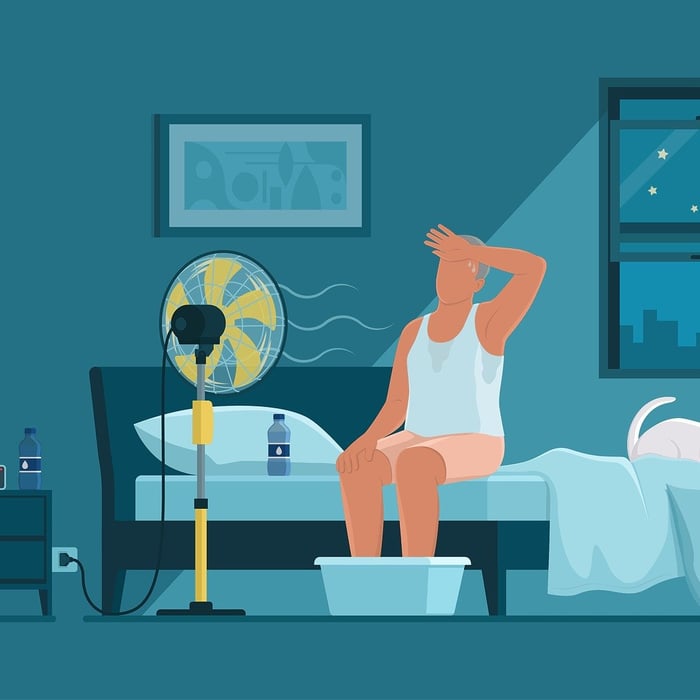Table of Contents
- Best Comforters for Hot Sleepers (2025 Guide, Ranked by Science)
- Wool comforters outperform every other option for hot sleepers — they wick away heat and humidity instead of trapping it, keeping your sleep environment naturally cool and balanced.How We Ranked the Best Comforters for Hot Sleepers
- #1 — Regenerative Wool Comforter (Best Overall)
- #2 — Organic Cotton Lightweight Quilt (Best Budget-Friendly Natural Option)
- #3 — Down Alternative Cooling Comforter (Best Synthetic Option, But Still Limited)
- #4 — Linen Quilt / Linen Blanket (Best for Dry Climates)
- #5 — Bamboo Comforter (Best “Marketing” Option, Not Best Real Option)
- FAQs on Wool Duvet Inserts, Comforters & Sustainable Bedding
Best Comforters for Hot Sleepers (2025 Guide, Ranked by Science)
Waking up overheated, sticky, or constantly tossing off the covers isn’t normal — and it’s definitely not comfortable. For hot sleepers, choosing the best comforters for hot sleepers can be the difference between a restless night and steady, balanced sleep. The wrong fill traps heat and humidity against your skin, while the right one releases it naturally.
This 2025 guide ranks the best comforters for hot sleepers using real science — thermoregulation, moisture vapor transfer, breathability, and humidity management — all explained simply.
And because natural materials outperform synthetics in every scientific metric, this guide leans into one core truth:
👉 Nature regulates temperature better than anything humans have engineered.
Let’s help you sleep cooler, deeper, and more comfortably.
Quick Answer (If You’re in a Hurry)
The best comforter for hot sleepers in 2025 is a lightweight wool duvet insert with natural moisture-balancing fibers.
It keeps you cooler when you’re warm and warmer when you’re cool — something synthetics, down, and “cooling” tech fills simply can’t do.
Why Hot Sleepers Overheat at Night
Your body cools itself at night by releasing heat and moisture. When your comforter traps either one, you experience:
Sudden heat spikes
Damp sheets
Clammy skin
Restless, fragmented sleep
That “kick the blankets off at 3am” cycle
Humidity is the real killer.
Synthetics and down trap moisture and warm air, creating a muggy microclimate that forces your body to sweat even harder.
Natural fibers — especially wool — do the opposite:
✔ Move moisture before it becomes sweat
✔ Release excess heat
✔ Balance humidity
✔ Maintain steady body temperature
That’s why natural is always better — and why this ranking is built around nature’s engineering, not synthetic marketing.

Based on scientific criteria:
1. Breathability (Airflow)
How easily warm air escapes from the fill.
2. Moisture Vapor Transfer
The ability to move humidity away from the skin.
3. Thermal Regulation
How effectively the material balances temperature changes.
4. Weight & Loft
Hot sleepers need light, airy construction.
5. Material Composition
Natural > synthetic due to physics, not preference.
6. Clean Sleep Standards
Hypoallergenic, non-toxic, OEKO-TEX / GOTS-aligned expectations.
The 5 Best Comforters for Hot Sleepers (Ranked by Science)
#1 — Regenerative Wool Comforter (Best Overall)
Why it ranks #1:
Wool is the only fiber on earth that regulates temperature in both directions — cooling you when you’re warm and warming you when you’re cool. This makes it the ideal companion for hot sleepers, night-sweat sufferers, and households with varying temperatures.
Scientific advantages:
Moves moisture vapor before it becomes sweat
Creates millions of tiny air channels for natural airflow
Absorbs up to 30% of its weight in vapor without feeling damp
Balances humidity — the real cause of overheating
Prevents heat spikes from waking you up
Why Antipodean Home’s wool is different:
Our spun wool Airlay design creates breathable “wool clouds” that increase airflow even further. Paired with GOTS-certified organic cotton, it’s the purest cooling system nature has.
This is the comforter that consistently solves overheating for hot sleepers.
Explore Our Bedding For Hot Sleepers Collection
#2 — Organic Cotton Lightweight Quilt (Best Budget-Friendly Natural Option)
Organic cotton doesn’t regulate humidity as dynamically as wool, but it still breathes better than polyester and dries faster than bamboo blends.
Best for:
Warm climates
Lightweight sleepers
Summer bedding
Avoid sateen for hot sleepers — choose percale for maximum airflow.
#3 — Down Alternative Cooling Comforter (Best Synthetic Option, But Still Limited)
If you must buy synthetic, choose a lightweight down-alternative designed for moisture movement. But keep expectations realistic:
✔ Light
✔ Soft
✘ Traps humidity
✘ Warms up over time
Still not ideal for true hot sleepers or night-sweat sufferers.
#4 — Linen Quilt / Linen Blanket (Best for Dry Climates)
Linen breathes exceptionally well and stays cool to the touch. But it lacks the humidity regulation needed for sweaty sleepers. Great layering piece; not a full replacement for a comforter.
#5 — Bamboo Comforter (Best “Marketing” Option, Not Best Real Option)
Bamboo is advertised as cooling, but most bamboo bedding is actually viscose — a semi-synthetic that traps humidity.
Breathable? Somewhat.
Moisture regulating? Not really.
Cool long-term? No.
Great for people who sleep warm, not people who sleep hot.
Comparison Table: What Actually Keeps Hot Sleepers Cool
| Material | Breathability | Moisture Control | Humidity Balance | Best For |
|---|---|---|---|---|
| Wool | ★★★★★ | ★★★★★ | ★★★★★ | Hot sleepers, night sweats |
| Organic Cotton (Percale) | ★★★★☆ | ★★★☆☆ | ★★★☆☆ | Warm climates |
| Linen | ★★★★☆ | ★★★☆☆ | ★★☆☆☆ | Dry heat |
| Down Alternative | ★★★☆☆ | ★★☆☆☆ | ★★☆☆☆ | Light warm sleepers |
| Bamboo Viscose | ★★★☆☆ | ★★☆☆☆ | ★☆☆☆☆ | Average sleepers |
Why Natural Comforters Beat Synthetic “Cooling” Ones Every Time
Cooling gels, cooling fibers, cooling coatings — none of them manage humidity. They feel cool for 5 minutes, then trap heat.
Natural bedding works with your biology.
Wool helps your core temperature drop at the start of sleep
Organic cotton helps air flow across your skin
Natural fibers allow your circadian rhythm to regulate properly
Synthetic bedding disrupts your biology.
Traps humidity
Causes temperature spikes
Overheats your microclimate
Nature restores balance. Synthetics fight against it.
Shop Our Bedding for Hot Sleepers Collection
Buying Guide: What to Look for in the Best Comforter for Hot Sleepers
1. Choose Natural Fibers
Keywords to reinforce: breathable bedding for hot sleepers, best bedding material for hot sleepers.
2. Avoid Heavy or High-Loft Constructions
Lightweight fill = cooler nights.
3. Pay Attention to Fabric Shell
Go for organic cotton — not microfiber, not polyester.
4. Prioritize Moisture Management Over “Cooling” Claims
Humidity > heat when it comes to comfort.
5. Look for All-Season, Not Summer-Specific
Wool regulates across seasons.
Final Thoughts: Choosing the Best Comforter for Hot Sleepers
Finding the best comforters for hot sleepers comes down to choosing materials that actually work with your body. When your bedding breathes, regulates moisture, and releases excess heat, your nights finally feel calm instead of chaotic.
Natural fibers—especially wool—give you that balance effortlessly. Cool, dry sleep isn’t a luxury.
It’s what your body was designed for.
Sleep Cooler, Naturally
If you’re tired of waking up hot, damp, or restless, it’s time to choose bedding that works with your body — not against it.
Our comforters are crafted from regenerative New Zealand wool and organic cotton, using natural materials that balance temperature, manage humidity, and help you breathe easier at night.
Live with nature, not against it.
Explore Our Bedding For Hot Sleepers Collection
FAQs on Wool Duvet Inserts, Comforters & Sustainable Bedding
What makes a comforter good for hot sleepers?
A great comforter for hot sleepers does two things exceptionally well: it releases heat and it moves moisture away from your skin before it turns into sweat. Most synthetic or down comforters trap warmth and humidity, creating that “wake-up-sticky” feeling. A truly cooling comforter uses breathable natural fibers like wool or organic cotton, which regulate temperature and humidity all night, keeping your body in its natural thermal comfort zone.
Are natural fibers really cooler than synthetic ones?
Yes — dramatically. Natural fibers like regenerative wool and organic cotton have a structure designed to breathe, absorb moisture vapor, and release excess heat. Synthetics like microfiber and polyester hold onto heat and humidity like a plastic bag. That’s why wool comforters consistently rank as the best comforters for hot sleepers in scientific tests: they cool when you’re overheating and warm you gently when your temperature dips.
What’s the difference between a cooling comforter and a lightweight comforter?
A lightweight comforter is simply thin — but that doesn’t guarantee cooling. A cooling comforter actively regulates your microclimate, meaning it manages heat and humidity intelligently. Wool is the only fill that does this naturally, thanks to its crimped structure that creates airflow channels. Lightweight down or microfiber may feel cool at first, but they quickly trap heat, making hot sleepers wake up sweaty.
Is wool too warm for hot sleepers?
Surprisingly, no — wool is one of the best bedding materials for hot sleepers because it adapts to your body. Wool fibers absorb moisture vapor before it becomes sweat and release it into the air, keeping your skin dry and cool. That’s why our regenerative New Zealand wool comforters outperform “cooling” bamboo and down alternatives in real-world temperature testing.
What comforter fill is worst for hot sleepers?
Down, down alternative, polyester, and microfiber are the biggest culprits. They trap heat, hold moisture, and create the warm, humid microclimate that leads to overheating. If you regularly toss off your covers or wake up damp, these materials are likely the reason.
Does thread count matter for hot sleepers?
Not really — higher thread counts often reduce airflow. What matters more is the fiber, the weave, and the overall breathability. A 300-thread-count organic cotton shell paired with a wool fill is ideal because it allows air to circulate naturally without feeling rough or flimsy.
How can I tell if my comforter is causing my night sweats?
If you wake up warm but damp, toss blankets off, feel sticky at the neckline, or only sleep well in cold weather, your comforter is trapping heat. Most hot sleepers find that switching from synthetics to natural fibers immediately reduces symptoms — especially when using a wool comforter engineered for airflow.
Is a wool comforter good for both hot and cold sleepers?
Yes — that’s the magic of wool. It’s an active fiber, meaning it warms when you’re cool and cools when you’re warm. Couples with different temperature preferences often find wool to be the only fill that keeps both people comfortable all night.
What’s the best comforter for hot sleepers who live in warm or humid climates?
Hot sleepers in warm climates need moisture vapor transfer, not just lightweight fill. Wool performs exceptionally well in humidity because it can absorb up to 30% of its weight in vapor while staying dry to the touch. Our regenerative wool comforters are designed exactly for this — thin, breathable, and engineered to reduce sweating in climates like Arizona, Texas, Florida, and the Pacific Coast.
What makes Antipodean Home’s comforter better for hot sleepers?
We use regenerative New Zealand wool with an Airlay design that spins wool into tiny breathable clusters. This boosts airflow, prevents heat buildup, and moves humidity before it becomes sweat. The result is a comforter that stays cool, dry, and balanced — perfect for hot sleepers who want a natural, chemical-free alternative to synthetic “cooling” marketing claims.




